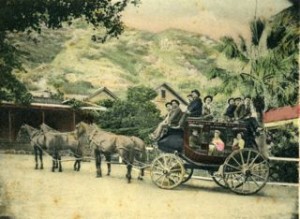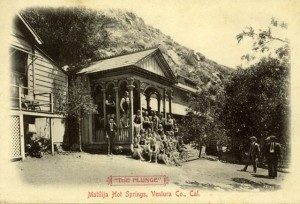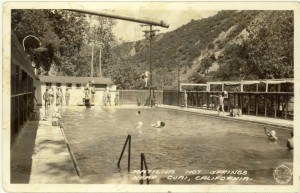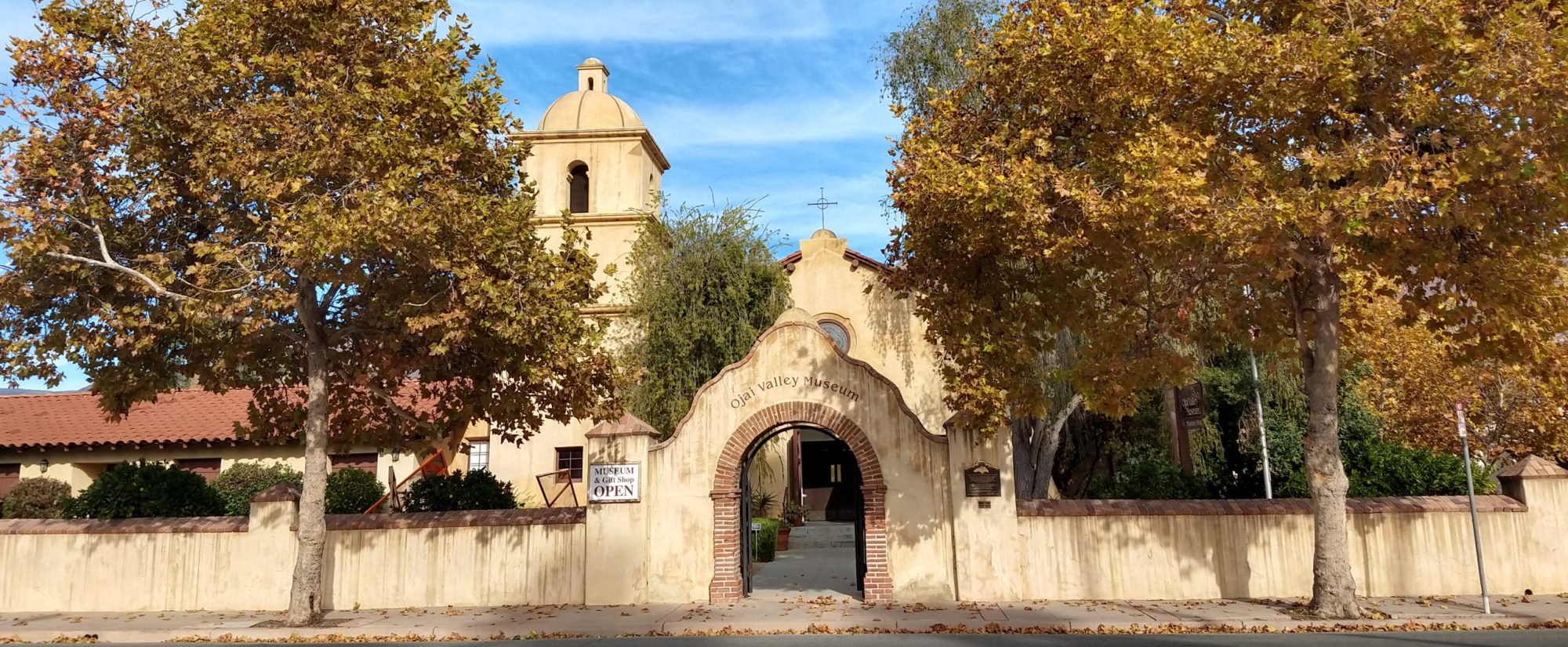This article was first published in the Ojai Valley News on October 22, 1994. It is used here with their permission.
MATILIJA HOT SPRINGS HAS COLORFUL HISTORY
By David Mason
“Matilija Hot Springs has had its grand opening for another season. The resort features a first class dining room, hot sulfur baths, medicinal waters, no fog and no winds. Board at the hotel is $12.00 a week and up; in tents, $2.50 a week.” – THE VENTURA FREE PRESS, MAY, 1904
Fountain of Life, Mother of Eve, Jacob’s Well and Celeste are the names of just a few of the springs that gush from the boulders in the Matilija Canyon.
When the springs were discovered in 1873 by J. W. Wilcox, he thought they might in some way be used for medicinal purposes. Wilcox camped beside the hot springs and bathed in the water for several weeks and discovered that his Mexican-War injury was slowly disappearing.
By 1875, the springs came into the ownership of R.M. Brown. With picks, spades, crowbars and an iron wheelbarrow, Brown set out to create a resort, taking advantage of the natural surroundings and the many hot and cold springs that flowed so freely out of the ground.
During the next two years, Brown built a long rambling building with a porch the entire length of its front and sides. The building became a hotel with 20 rooms to let. He also built six cabins for additional sleeping rooms.
The Arroyo Matilija, now Matilija Creek, ran behind the hotel, and there was a small footbridge to cross the river to a green meadow on the other side. In the meadow was built a large bathhouse with hot showers and sulfur baths. For an additional fee, one could even enjoy a “mud bath.” Brown then constructed a good road to his resort.
The Matilija Springs opened to the public in 1877, but not under Brown’s ownership, for he had sold the whole of the land, buildings and resort to Capt. Gardner even before the buildings were finished. Gardner gave the area the name of Matilija Springs. Gardner brought with him from San Francisco, Captain La Guad as the resorts new manager. La Guad was well known in San Francisco as a very fine chef. The guest and all the employees were very fond of the new manager.
Gardner decided to expand his operation in the canyon by bringing in hundreds of beautiful thoroughbred Angora goats. He felt that within a very short time, he would have a thriving wool-bearing ranch, however he did not take into consideration that with the low and thorny underbrush, the animals silken fur would be ruined. The goats stayed around the resort for a few years, as a great source of amusement for the guests.
In 1881, Gardner sold the springs to a Mr. Wilcoxen, from Arizona, to be used as a private home. The Wilcoxen’s had wanted a place with healing qualities because of the failing health of a grandson, Arnold Carver, who lived with them. The boy died after a serious fall, while out hunting one day. The Wilcoxen’s then opened the springs to other family members and visitors.
The resorts popularity grew as publications about the Santa Barbara and Ventura Counties included the hot springs. In 1883, Thompson and West wrote “These grounds, intersected by limpid streams, seem to have been selected by nature as a spot of earth where the chemistry of her great laboratory for the cure of diseases displays itself in great perfection. There are twenty-two of the springs and it is a remarkable fact that the quantity of water discharged never varies: It is the same in the hottest and driest spells of weather.”
The temperature of the water flowing from the springs was from 35 degrees to 150 degrees. The mountain streams were full of trout and the neighboring hills were the home of deer, quail and rabbits.
As for the health benefits, the papers wrote; “The pure mountain air, freedom from wind and dust, and the equal climate, combined with its healing waters, stimulate nature to her own best restoration processes. The effect on the healthy body of the sojourner here is to incite them to the highest mental and bodily efforts. A wholesome feeling of energy pervades and fits a man for his best and steadiest work.” The Matilija Springs resort was destroyed in the flood of 1884.
A. W. Blumberg who owned the small Blumberg Hotel in the town of Nordhoff, now Ojai, filed a claim on some of the land in the Matilija Canyon, and decided to use the springs to create a new resort and health center, appropriately call Matilija Hot Springs.
Blumberg built several small cozy cottages and furnished them for the comfort of guests. Around these cabins and among the nearby boulders, he placed tents for camping parties, and in another area, he built a stable for horses. He then built a small store for the convenience of campers and another building which was used for an office and dining room.
The new Matilija Hot Springs would now accommodate up to 100 people aside from those who had chosen to live in tents and board themselves.
Stagecoaches were the only means of public transportation to the Matilija Hot Springs, and the tourists flocked to the new resort. With so many tourists, it became necessary to open another business, the Matilija Post Office. The post office opened for business on July 22, 1889 and remained in operation for 27 years. The outlook for the future of the springs seemed very bright. All the guests were enthusiastic over the beauty of the canyon and its healing waters.

In 1901, the Blumbergs sold the resort to S. P. Creasinger, a real estate broker and developer. Creasinger paid $20,000 for the resort on eighty acres and an additional three hundred and twenty acres. By 1903, Creasinger was advertising his “Popular Summer and Winter Resort” as a “beautiful spot tendered attractive by nature (which) had been made more beautiful by the hand of artifice and the generous expenditure of money. A mammoth pleasure pavilion and numerous new cottages are among the improvements. The grounds were even illuminated by electric lights.”

Creasinger lost the Matilija Hot Springs in a bankruptcy hearing in January 1904, and the property came into the ownership of Sim Myers of Oxnard, who purchased the place for $12,000. It would end up costing Myers more than he had anticipated. In July of 1907, Myers was charged with selling liquor without a license.
Mr. A. C. Rallya, of Chicago, a member of the Thiel Detective Agency, brought the charge against the Hot Springs. Rallya stopped at the springs for about a week and claimed to have evidence of infractions of the law. Myers, not contrary to formal charges of like character, offered no defense and the court imposed a fine on him of $300. Other charges being in evidence, the court promised Myers immunity from them, providing he would promise not to sell intoxicating drinks from now on.
The local paper, The Ojai, reporting the incident, said that they “hope that the charming resort has sufficient real attractions to afford Mr. Myers a successful career without evasion of the county ordinance.”
Then another flood raged through the canyon, with damage estimated at $50,000 to the resort’s buildings. This loss caused Myers to lose his investment. The Levy’s Bank of Oxnard took over the resort and leased it for many years, and it turned out to be a financial disaster for the bank.
In 1920, Joe Linnel, who had managed the old Blumberg Hotel in the town of Ojai, took over the Matilija Hot Springs. In 1938, G. E. Mann was in charge of the resort. Mr. and Mrs. Ray Robertson leased the Matilija Hot Springs in 1941 and ran a successful operation until 1949.
Many names of famous guests appeared on the register of the splendid “Old Western Hotel” during its years of public attraction. One of the guests was President and Mrs. Herbert Hoover, who stayed overnight and enjoyed the dining room that had achieved a reputation far and wide for its delicious food served in the atmosphere of splendor that surpassed many of the “big city” restaurants.
In 1946, the Ventura County flood control district bought the springs and the land surrounding it. The county wanted the land to build a dam in order to create a water storage lake behind the resort.

In 1965, Mr. and Mrs. Bill Olivas leased the Matilija Hot Springs resort and spa. The 1969 flood did considerable damage to the swimming pool and some of the buildings, but through the efforts of Bill Olivas, the resort was restored to its former glory.
In 1988, the county sold the property to a Santa Barbara man, and it is once more closed to the public.
